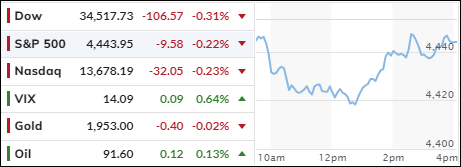
- Moving the markets
The markets had a bad hair day on Tuesday as they waited for the Federal Reserve to wake up and make a move. After plunging in the middle of the day, the major indexes clawed their way back up but still ended in the red.
The central bank’s two-day meeting started on Tuesday, but nobody expected any surprises. The Fed was likely to keep rates unchanged on Wednesday, with traders betting 99% that the bank would hit the snooze button. Traders were also skeptical that the Fed would hike rates in November, giving it only a 29% chance.
The Fed was also supposed to give some economic forecasts on Wednesday, but investors were more interested in what the bank would say about inflation and interest rates.
Would the Fed admit that prices were rising faster than expected? Would the Fed hint at when it would start tapering its bond-buying program? Would the Fed crack a joke to lighten the mood?
Analysts believed that the Fed was trying to land the economy softly, like a feather on a pillow. Consumer spending was strong in the summer, but economists predicted that it would slow down as people ran out of stimulus money. Plus, many young Americans had to start paying back their student loans, which meant less money for avocado toast and Netflix.
Oil prices soared on Tuesday, with Brent crossing the $95 mark. The surge in prices helped energy stocks within the S&P 500 reduce their losses in the index. Oil was having a blast, unlike bonds, which were having a blast from the past. Bond yields jumped to 16-year highs, which made their prices drop to their lowest level since October 2007.
The markets realized that the Fed was not kidding when it said it would keep rates higher for longer. Next year’s rate hike expectations skyrocketed, which made bond investors cry.
As a result, regional banks kept sinking, as they struggled to make money from lending. The dollar was also confused, as it moved up and down without direction. Gold tried to rally but gave up and closed flat. Oil prices had a wild ride, as they spiked and then dropped, with WTI finding support at $90.
The gap between bonds and the S&P 500 was obvious and raised a question: “Which way will the alligator jaw snap shut?” Will bonds catch up with stocks or will stocks fall and catch up with bonds?
Or will they both get eaten by the alligator?
2. “Buy” Cycle Suggestions
The current Buy cycle began on 12/1/2022, and I gave you some ETF tips based on my StatSheet back then. But if you joined me later, you might want to check out the latest StatSheet, which I update and post every Thursday at 6:30 pm PST.
You should also think about how much risk you can handle when picking your ETFs. If you are more cautious, you might want to go for the ones in the middle of the M-Index rankings. And if you don’t want to go all in, you can start with a 33% exposure and see how it goes.
We are in a crazy time, with the economy going downhill and some earnings taking a hit. That will eventually drag down stock prices too. So, in my advisor’s practice, we are looking for some value, growth and dividend ETFs that can weather the storm. And of course, gold is always a good friend.
Whatever you invest in, don’t forget to use a trailing sell stop of 8-12% to protect yourself from big losses.
3. Trend Tracking Indexes (TTIs)
The markets faced a setback as interest rates reached their highest level since 2007, eroding investors’ confidence and optimism. However, the major indexes rallied in the middle of the day and reduced some of their initial losses.
Our Domestic TTI was close to breaking its trend line to the downside, but it managed to avoid this outcome for now.
This is how we closed 09/19/2023:
Domestic TTI: +0.26% above its M/A (prior close +0.42%)—Buy signal effective 12/1/2022.
International TTI: +3.51% above its M/A (prior close +3.53%)—Buy signal effective 12/1/2022.
All linked charts above are courtesy of Bloomberg via ZeroHedge.
Contact Ulli